LEGO Pathfinder Campaign – The Bestiary (Bad guys)
These are some pictures of the monsters I have for the players to encounter. Not complete by any stretch of the imagination, lol.

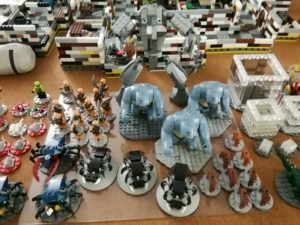
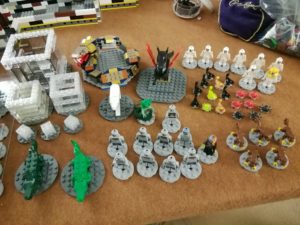
These are some pictures of the monsters I have for the players to encounter. Not complete by any stretch of the imagination, lol.



So, this is what is behind my DM screen, and a few details of how I play.
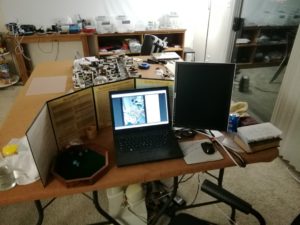
And a picture from the front.
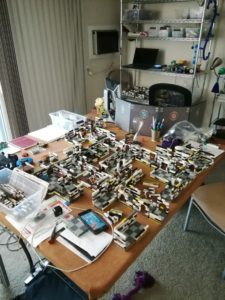
I play with a notebook and a second screen in portrait mode so I can easily look things up, view handbooks or change music.
I installed speakers and a subwoofer under the table, it makes the music really immersive. (I’m sure my downstairs neighbors love me, lol)
I have an hourglass on the table that I flip when I want to get the players attention for something.
I bought a magnetic Pathfinder Combat Pad to track initiative. I let the players manage it.
I have a full set of Rory’s Story Dice that I use when I need excess “fluff” story. (Like when you want to give an NPC simple backstory.)
The wooden dice tray I use I got on Amazon. It was relatively cheap but I like it quite a bit.
Behind me there is an extra notebook computer for the players to use. And connected to it is an old Skylanders “Portal of Power”. When you hook it up to a Linux computer it lights up and changes color randomly. (Makes for a fun immersive coaster)
I also have several wood and metal “chest shaped” boxes with misc things in them like rocks, keys, scrolls, letters, real animal teeth, etc. This adds to the immersive feel and allows the players to have a real feeling of “items” in the game.
On the far side of the room is a set of glass beer mugs. They make for decent game-appropriate drink containers, and they are VERY bottom heavy so the players (hopefully) won’t tip them over.
A few things I still want to add are some magic wand props and a more sorted musical playlist.
Here we have some pictures of the ongoing D&D LEGO campaign.
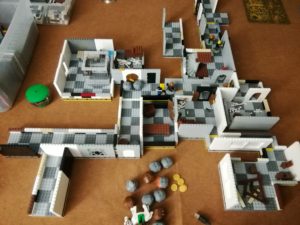
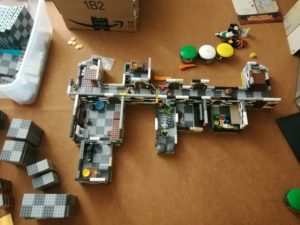
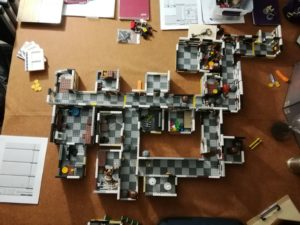
My next task is to find a way to deal with cavern and sloping walls. For now I can just keep the map square since it’s all homebrew, heh.
So, a few people have asked me for details about the builds I am using in my Pathfinder game. I will attempt to give them here. 🙂
I tried to combine “What will look good” with “What is affordable”. Sometimes price won out, sometimes looks did. Overall I’ve sunk $200 into the project so far, beyond the LEGO I already had on hand.
I settled on 4×4 plates to serve as 5′ squares. This gave a starting scale to everything. It’s not perfect but it works alright. I did not have enough of these plates on hand so I bought about 300 each in light bluish gray and dark bluish gray.
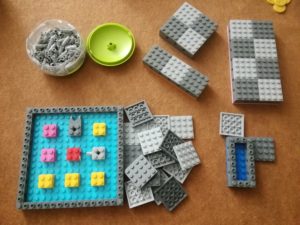
The plates I used for the subfloor I already had on hand in various sizes. But if you do not have large plates don’t worry, I found that 8×8, 4×8, and 12×8 are the best sizes, This allows the checkerboard pattern to always be lined up properly. I bought around 1000 technic pins to make the connections. (I store these in X-pods which I think are terrific little holders)
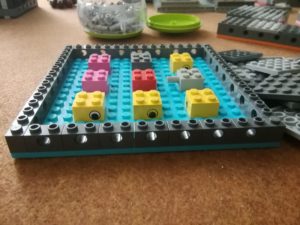
I bought around 2000 1×2 technic-hole bricks to use for the connection edges. This granted me three benefits. #1 1×2’s were cheap, very cheap. #2 The connections would always be properly spaced. (Every checkerboard would always have a technic hole in the center) #3 I could always use the 1×2’s in any size floor piece I wanted to make regardless of how big or small it is. (I made one piece of floor that is 32×32 studs from 4x 16×16 plates and 2×4 brick internal supports/connectors. It turned out surprisingly tough)
I used “extra” bricks to fill in the center that holds up the floor tiles since these will never be seen (odd colors, odd brand blocks, pieces with connections I never use, etc,)
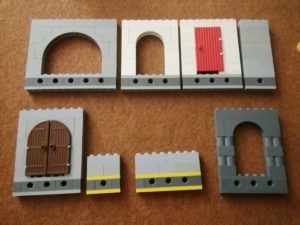
After making what I hope is enough flooring I moved on to the walls. I figured 7 bricks high would be enough. I also made short walls for one side to allow the players to more easily see into the setup, and move their minis. Along with that, I made archways and doors which allow a 1-brick offset between rooms so I don’t deal with 2 walls trying to take up the same inside corner point.
I bought several thousand 1x# plates in yellow (due to it being cheapest) and used them for the short walls. This allows me to know what piece is intentionally a short wall, and what piece has broken apart in the bucket of walls.
I used solid colors on the walls for the moment, but eventually, I plan to break all the walls apart and rebuild with random colors. I decided against using red/blue/yellow for the walls simply because it didn’t look very good at all. But I also had enough grays/black/white on hand to use. If I didn’t have what I did I would probably do something like this: http://www.legogm.com/2015/05/lego-terrain-101.html and only use bright colors if I had no other option.
I will likely add wall-decorations later like torches, paintings, etc.
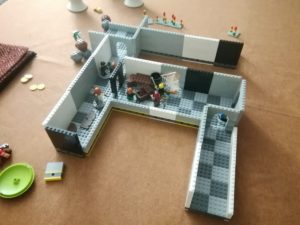
And here we have a finished map with the campaign well underway for it’s first adventure session.
Thanks!
| S | M | T | W | T | F | S |
|---|---|---|---|---|---|---|
| 1 | 2 | 3 | 4 | 5 | ||
| 6 | 7 | 8 | 9 | 10 | 11 | 12 |
| 13 | 14 | 15 | 16 | 17 | 18 | 19 |
| 20 | 21 | 22 | 23 | 24 | 25 | 26 |
| 27 | 28 | 29 | 30 | |||


54 queries. 0.074 seconds